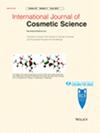Development and evaluation of a polymer material-based formulation for non-surgical nasolabial fold reduction
Abstract
Objective
Currently, nasolabial folds are mainly removed by invasive procedures, resulting in long-lasting changes, as non-surgical user-implementable alternatives are scarce and inefficient. For example, the use of coating films for this purpose has thus far faced substantial difficulties because such films should combine the antithetical properties of shrinkability and flexibility. Herein, we challenge this status quo by identifying a polymer that simultaneously exhibits shrinkability and flexibility and using this polymer to develop a cosmetic formulation for immediate and non-invasive nasolabial fold removal.
Methods
The developed formulation, namely a solution of norbornene/tris(trimethylsiloxy)silylnorbornene copolymer in disiloxane, was tested on a group of Japanese women using visual evaluation, three-dimensional shape analysis and ultrasonography. The polymer film obtained upon drying the formulation was subjected to shrinkage and flexibility tests, and its synchronization with the skin was examined using optical microscopy. The free volume of the polymer films was evaluated using positron annihilation measurements and molecular dynamics simulations.
Results
Upon application, the liquid formulation rapidly dries to produce a skin-synchronized polymer film that exhibits significant drying-induced shrinkage without cracking, thereby exerting a lift-up effect and inducing changes in the internal skin structure to efficiently reduce the nasolabial fold, providing a feeling of rejuvenation. On average, the proposed treatment decreases the nasolabial fold depth by 1 mm, increases the opening angle of the nasolabial fold by 11.5° and reduces the hypodermis thickness by 0.2 mm.
Conclusion
Our results facilitate the development of cosmetic products targeting the nasolabial fold and inspire further research in this field.


 求助内容:
求助内容: 应助结果提醒方式:
应助结果提醒方式:


